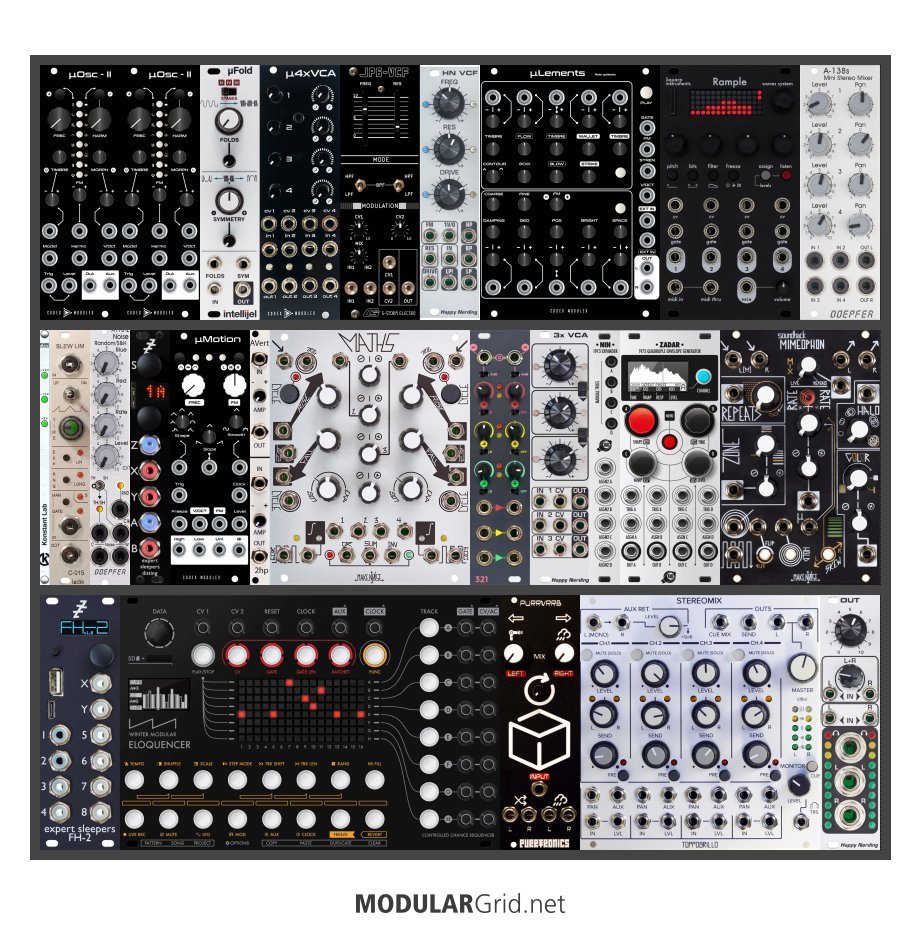Well, I had a bash at this...probably good, too, as there were some discontinued and/or wrong versions of modules in the original build. Plus, there was a LOT missing...attenuverters, modulation utilities, and so on. Plus, in this sort of case, you've GOT to minimize space while maximizing function. Now, it might SEEM like a bunch of your modules are missing here, but what I've done is to replace everything that could be "shrunk" with their smaller counterparts in a number of cases. Plus, the AS modules were deep...as in, REAL deep, to the point that I had some concerns about the depth on them. In others, I just reworked things altogether, such as the drum modules (gone...and you'll see why in a bit). Anyway, the result I got was:

OK...so, what's going on here? Let's have a look...
Top row: Single Plaits: gone. Replacement: TWO Plaits clones. Two VCOs is always better...you can detune them for a huge, fat sound, or you can split 'em out as individual voice sources, or you can use one to FM the other, and so on. Added a wavefolder for even crazier timbral tampering under CV control. Quad VCA: also gone. Replacement: Codex Modulex's clone of the Mutable Veils, basically the same thing minus 4 hp. Then the VCFs...I tossed the earlier ones, and went with one very different one and one not so different one. The "very" is G-Storm's clone of the famous and wonderful Roland JP-6 filter, while the "not so" is the version of Happy Nerding's SVF which has the other modulation/control inputs, as opposed to the one that was there. Same core, better tricks. Also, the G-Storm filter has its own 2-in mixer, so if you want to bypass the VCAs altogether, you can send both Plaits clones directly. Elements got shrunk by a whole bunch, again thanks to Codex Modulex. And THIS allowed the next two modules...one is a stereo mixer, as you can see...and the OTHER is Squarp's Rample, a four-channel sampler/looper. Now, remember that thing about the drums? This not only fixes that (if you use it for drum samples), but gives you the ability to submix the entire sampling module and send it to...well, we'll get to that...
Middle row: Konstant Labs PWRchekr, because it's good to be able to keep an eye on your DC rail performance. Then Ladik's little gated slew limiter, for portamento and such. After that, I added one of Doepfer's useful utility modules, with this one having noise and random sources, and a sample and hold that can be switched to track-and-hold. Kept one Disting, and it's next...then the Tides got shrunk. Right after that, you'll find a 2hp attenuverter...very useful for inverting Tides outputs if desired. Maths is next (the right version), then a Frap 321 lets you mix, mangle, alter, and screw with in general your modulation sources. A 3xVCA is next so that you'll have some DC-coupled linear VCAs for modulation level control. Then FOUR envelope gens are hiding in the Zadar (which has its Nin expander here as well). And the last thing is more for the mixer below...or you can use it with the stereo mix from the Rample...a Make Noise Mimeophon stereo delay with loads of timbral options.
Bottom row: the original MIDI interface was just too clunky, so I chucked it in favor of an Expert Sleepers FH-2. This is not merely a MIDI-in interface, but also a class-compliant keyboard (via USB) interface, which will let you connect any keyboard that outputs MIDI over USB directly to the synth. MUCH more potent! Eloquencer's next...then next to it is another FX module, in this case a Purrtronics spring reverb emulator, which is a mono-in, stereo-out device, and you need that sort of I/O for the mixer. And that mixer is a Toppobrillo Stereomix2...which gives you VCAs on each input, plus CV over panning and AUX sends. You also have silent mutes, a CUE bus...and importantly, a mono AUX send and stereo AUX return. Then that last module is a Happy Nerding OUT...offering your main headphone preamp (the Stereomix2 has one as well, but you might find that one more useful for the CUE function) and a little surprise: TWO stereo inputs, one of which has its own input level (pre-fader...yep, you also have a ganged stereo level control) so that you can fly a stereo signal over the rest of the mix. Remember that thing about the Rample's submixer? That's one good use for the second stereo input. Another might be to split your AUX send, send one to the reverb, and the other to the Mimeophon, then you can mix the Mimeophon back in via the extra stereo in.
So...what happened? Basically, I made things smaller while pushing to INCREASE the functionality. Also, you'll notice that everything's been reordered so that you have cohesive function "groups", which function together as opposed to just a collection of modules. I added some very necessary utilities, also...and so on, until this was the result. And the fun part is that it's only a couple of hundred bucks (if that) more than the original once I put the Eloquencer back into it. This should be far more functional than the original, plus it offers some interesting NEW functions that you might not have thought of, like the JP-6 filter clone or the 4-channel sampler, some effects, full CV control over your main mixer, etc etc etc. Very beefed up.

